MOCVD Growth and Investigation of InGaN/GaN Heterostructure Grown on AlGaN/GaN-on-Si Template
Abstract
:1. Introduction
2. Experimental Details
3. Results and Discussion
4. Conclusions
Supplementary Materials
Author Contributions
Acknowledgments
Conflicts of Interest
References
- Ťapajna, M.; Hilt, O.; Bahat-Treidel, E.; Würfl, J.; Kuzmík, J. Investigation of gate-diode degradation in normally-off p-GaN/AlGaN/GaN high-electron-mobility transistors. Appl. Phys. Lett. 2015, 107, 193506. [Google Scholar] [CrossRef]
- Zhang, K.; Sumiya, M.; Liao, M.; Koide, Y.; Sang, L. P-channel InGaN/GaN heterostructure metal-oxide-semiconductor field effect transistor based on polarization induced two-dimensional hole gas. Sci. Rep. 2016, 6, 23683. [Google Scholar] [CrossRef] [PubMed]
- Zhou, H.; Lou, X.; Kim, S.B.; Chabak, K.D.; Gordon, R.G.; Peide, D.Y. Enhancement-Mode AlGaN/GaN Fin-MOSHEMTs on Si Substrate with Atomic Layer Epitaxy MgCaO. IEEE Electron. Device Lett. 2017, 38, 1294–1297. [Google Scholar] [CrossRef]
- Del Alamo, J.A. Nanometre-scale electronics with III-V compound semiconductors. Nature 2011, 479, 317. [Google Scholar] [CrossRef] [PubMed]
- Shatalov, M.; Simin, G.; Zhang, J.; Adivarahan, V.; Koudymov, A.; Pachipulusu, R.; Asif Khan, M. GaN-AlGaN p-channel inverted heterostructure JFET. IEEE Electron. Device Lett. 2002, 23, 452. [Google Scholar] [CrossRef]
- Li, G.; Wang, R.; Song, B.; Verma, J.; Cao, Y.; Ganguly, S.; Jena, D. Polarization-induced GaN-on-insulator E-D mode p-Channel heterostructure FETs. IEEE Electron. Device Lett. 2013, 34, 852. [Google Scholar] [CrossRef]
- Hahn, H.; Reuters, B.; Pooth, A.; Hollander, B.; Heuken, M.; Kalisch, H.; Vescan, A. p-channel enhancement and depletion mode GaN-based HFETs with quaternary backbarriers. IEEE Trans. Electron. Devices 2013, 60, 3005. [Google Scholar] [CrossRef]
- Hahn, H.; Reuters, B.; Pooth, A.; Noculak, A.; Kalisch, H.; Vescan, A. First small-signal data of GaN-based p-channel heterostructure field effect transistors. Jpn. J. Appl. Phys. 2013, 52, 128001. [Google Scholar] [CrossRef]
- Reuters, B.; Hahn, H.; Pooth, A.; Hollander, B.; Breuer, U.; Heuken, A.; Kalisch, H.; Vescan, A. Fabrication of p-channel heterostructure field effect transistors with polarization-induced two-dimensional hole gases at metal–polar GaN/AlInGaN interfaces. J. Phys. D Appl. Phys. 2014, 47, 175103. [Google Scholar] [CrossRef]
- Kumakura, K.; Makimoto, T.; Kobayashi, N. Mg-acceptor activation mechanism and transport characteristics in p-type InGaN grown by metalorganic vapor phase epitaxy. J. Appl. Phys. 2003, 93, 3370. [Google Scholar] [CrossRef]
- Yeo, Y.C.; Chong, T.C.; Li, M.F. Electronic band structures and effective-mass parameters of wurtzite GaN and InN. J. Appl. Phys. 1998, 83, 1429. [Google Scholar] [CrossRef]
- Yu, E.T.; Dang, X.Z.; Asbeck, P.M.; Lau, S.S.; Sullivan, G.J. Spontaneous and piezoelectric polarization effects in III-V nitride heterostructures. J. Vac. Sci. Technol. B 1999, 17, 1742. [Google Scholar] [CrossRef]
- Sang, L.; Liao, M.; Koide, Y.; Sumiya, M. High-performance metal-semiconductor-metal InGaN photodetectors using CaF2 as the insulator. Appl. Phys. Lett. 2011, 98, 103502. [Google Scholar] [CrossRef]
- Sang, L.; Liao, M.; Koide, Y.; Sumiya, M. InGaN-based thin film solar cells: Epitaxy, structural design and photovoltaic properties. J. Appl. Phys. 2015, 117, 105706. [Google Scholar] [CrossRef]
- Sang, L.W.; Qin, Z.X.; Fang, H.; Zhou, X.R.; Yang, Z.J.; Shen, B.; Zhang, G.Y. Study on threading dislocations blocking mechanism of GaN/AlxGa1−xN. Appl. Phys. Lett. 2008, 92, 192112. [Google Scholar] [CrossRef]
- Inatomi, Y.; Kangawa, Y.; Ito, T.; Suski, T.; Kumagai, Y.; Kakimoto, K.; Koukiku, A. Theoretical study of the composition pulling effect in InGaN metalorganic vapor-phase epitaxy growth. Jpn. J. Appl. Phys. 2017, 56, 078003. [Google Scholar] [CrossRef]
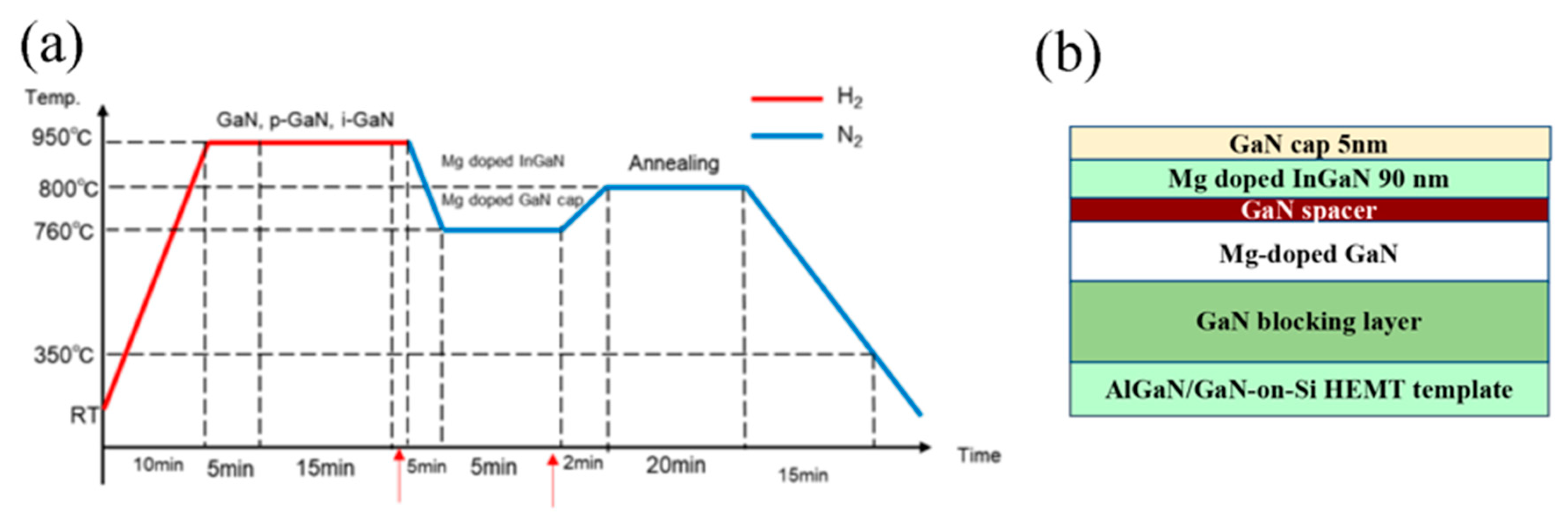
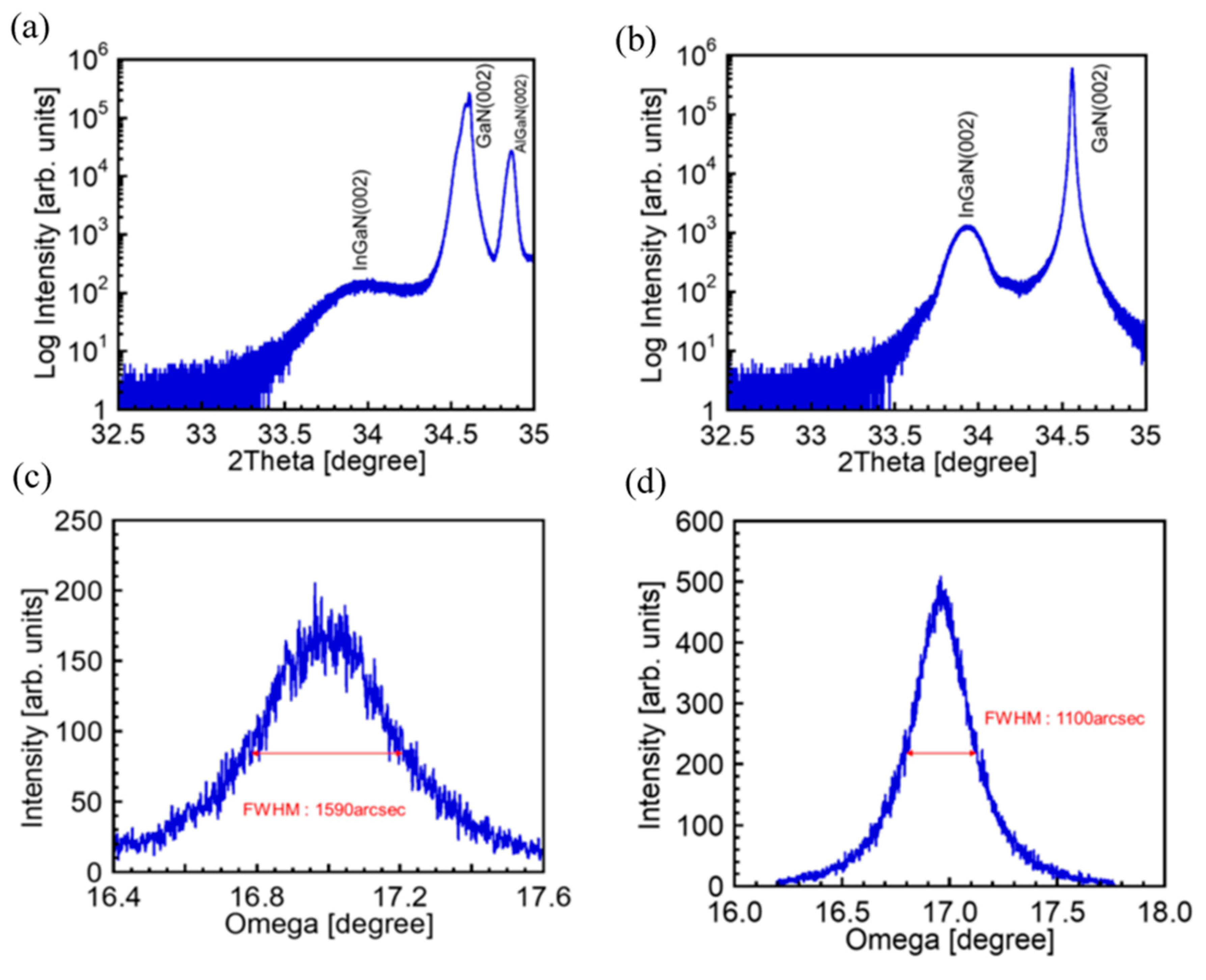
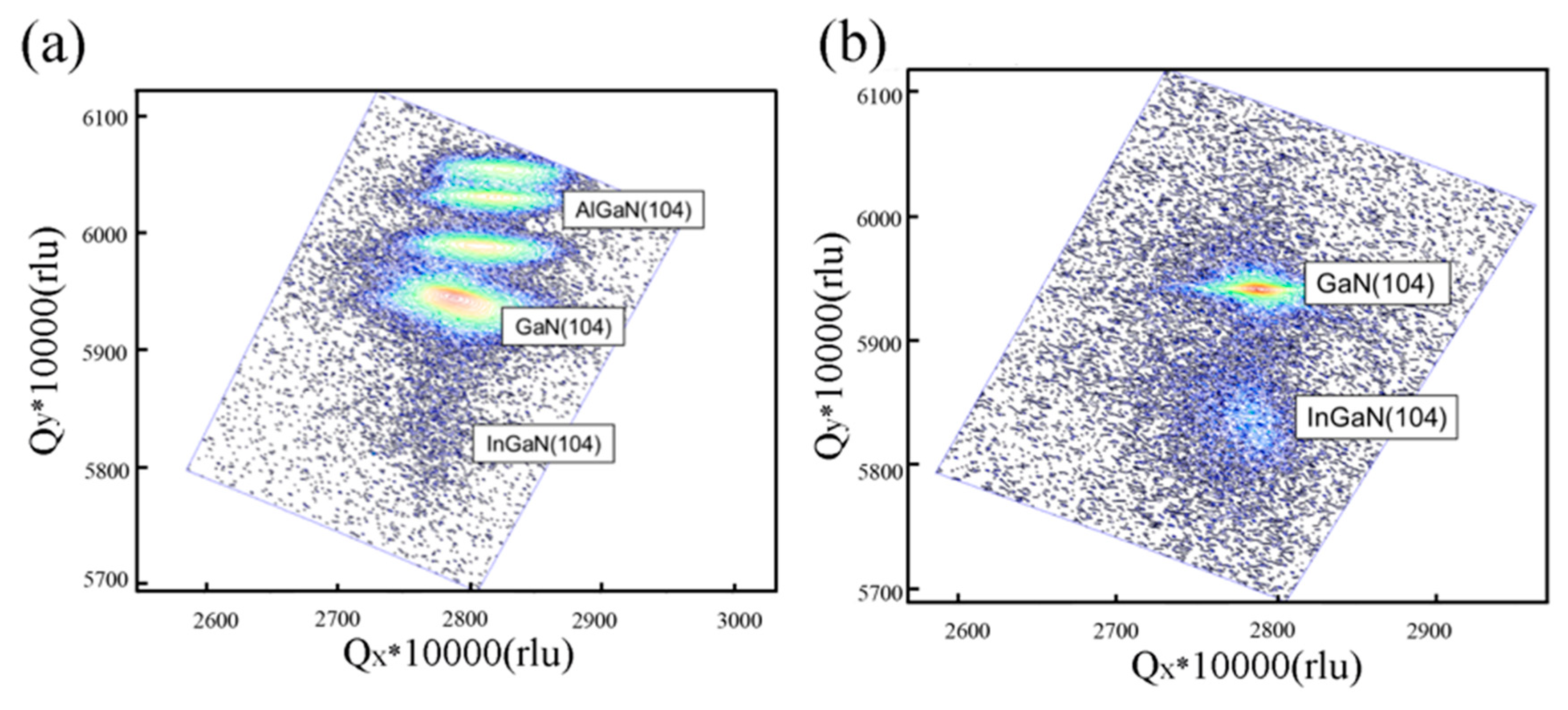
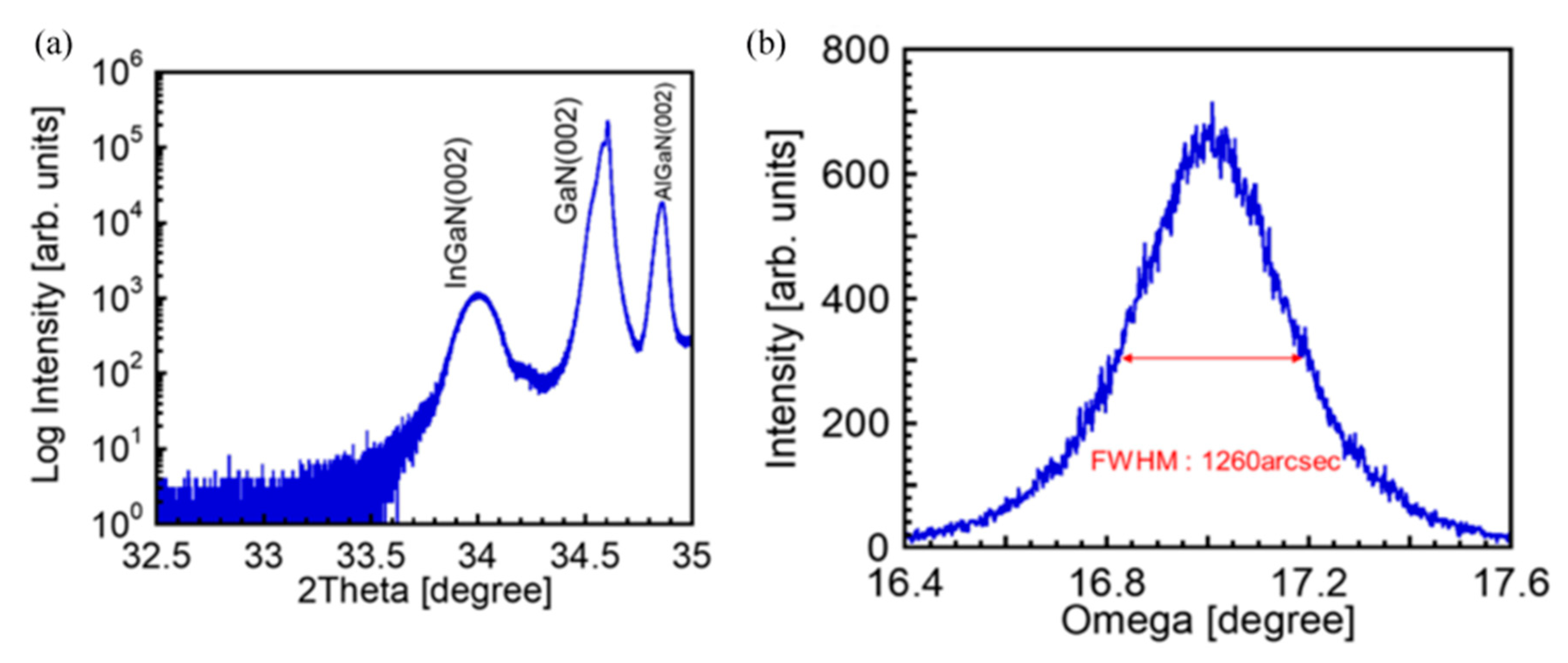
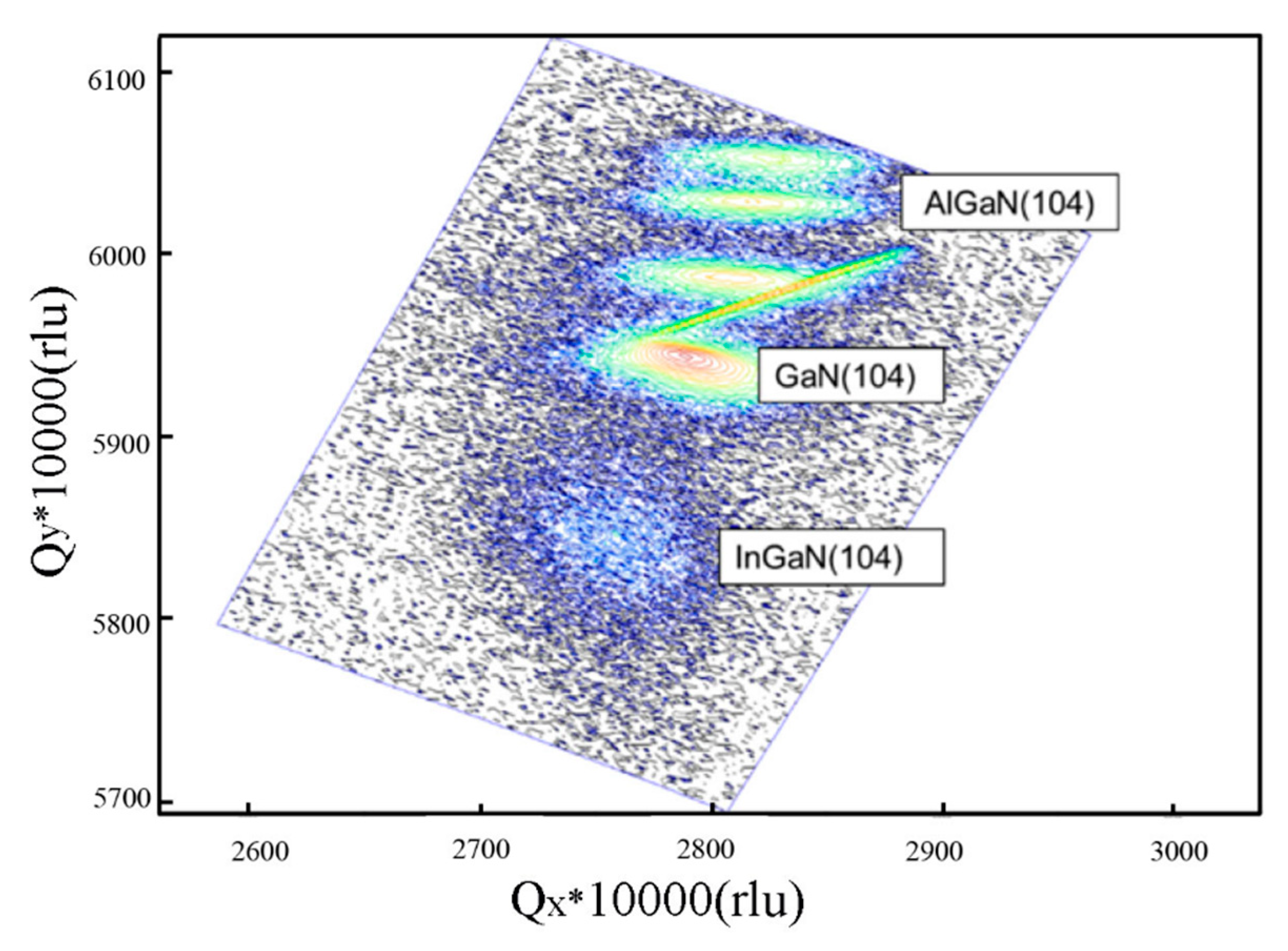
| Sample | CGaN (Å) | CInGaN (Å) | In% | Relaxation (%) |
|---|---|---|---|---|
| InGaN/GaN on sapphire (760 °C) | 5.186 | 5.280 | 11 | 3.9 |
| InGaN/GaN on HEMT (760 °C) | 5.179 | 5.272 | 16 | 30 |
| InGaN/GaN on HEMT (780 °C) | 5.180 | 5.269 | 14 | 73 |
© 2019 by the authors. Licensee MDPI, Basel, Switzerland. This article is an open access article distributed under the terms and conditions of the Creative Commons Attribution (CC BY) license (http://creativecommons.org/licenses/by/4.0/).
Share and Cite
Matsuura, H.; Onuma, T.; Sumiya, M.; Yamaguchi, T.; Ren, B.; Liao, M.; Honda, T.; Sang, L. MOCVD Growth and Investigation of InGaN/GaN Heterostructure Grown on AlGaN/GaN-on-Si Template. Appl. Sci. 2019, 9, 1746. https://doi.org/10.3390/app9091746
Matsuura H, Onuma T, Sumiya M, Yamaguchi T, Ren B, Liao M, Honda T, Sang L. MOCVD Growth and Investigation of InGaN/GaN Heterostructure Grown on AlGaN/GaN-on-Si Template. Applied Sciences. 2019; 9(9):1746. https://doi.org/10.3390/app9091746
Chicago/Turabian StyleMatsuura, Haruka, Takeyoshi Onuma, Masatomo Sumiya, Tomohiro Yamaguchi, Bing Ren, Meiyong Liao, Tohru Honda, and Liwen Sang. 2019. "MOCVD Growth and Investigation of InGaN/GaN Heterostructure Grown on AlGaN/GaN-on-Si Template" Applied Sciences 9, no. 9: 1746. https://doi.org/10.3390/app9091746
APA StyleMatsuura, H., Onuma, T., Sumiya, M., Yamaguchi, T., Ren, B., Liao, M., Honda, T., & Sang, L. (2019). MOCVD Growth and Investigation of InGaN/GaN Heterostructure Grown on AlGaN/GaN-on-Si Template. Applied Sciences, 9(9), 1746. https://doi.org/10.3390/app9091746






